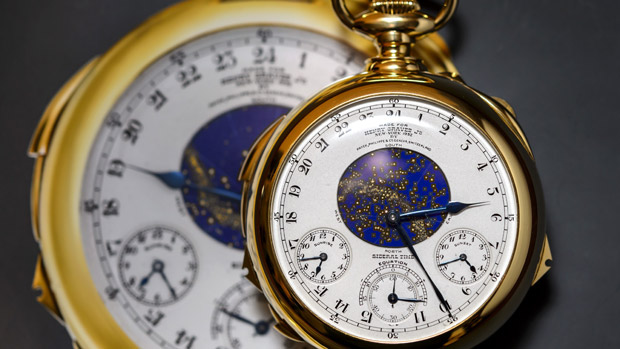World's most complicated watch sells for a record £13.4m
The Henry Graves Supercomplication was made for a New York City banker in the 1930s

A watch believed to be the most complex ever built without the help of computers sold at auction yesterday for a new world record: £13.4m. The Henry Graves Supercomplication was made by Patek Philippe in the 1930s.
The gold pocket watch is known as the pinnacle of the watchmakers art because of its 24 'complications', says the BBC. A complication is a watchmaker's term for any extra feature which does more than simply tell the time.
Wealthy banker Henry Graves wanted a watch with more complications than anyone else - in particular his rival, automotive pioneer James Packard, who had recently commissioned a watch for himself with 10 complications, including a star map.
The Week
Escape your echo chamber. Get the facts behind the news, plus analysis from multiple perspectives.

Sign up for The Week's Free Newsletters
From our morning news briefing to a weekly Good News Newsletter, get the best of The Week delivered directly to your inbox.
From our morning news briefing to a weekly Good News Newsletter, get the best of The Week delivered directly to your inbox.
Graves, who had been born into a dynasty of rich financiers, commissioned Swiss firm Patek Philippe to make him something even better. After three years of research and five of manufacturing, the watch was finished in 1932.
With 900 parts, the Henry Graves Supercomplication remained the most sophisticated watch ever built for 56 years. It was only beaten by watchmakers working with the help of computers.
Although the watch has not been wound up since 1969, it is still in working order. Among its features is a rotating map of the stars as they appear from Graves's apartment on Fifth Avenue in New York.
The watch also indicates sidereal time, which is used by astronomers to keep track of the stars and planets. A sidereal day is approximately 23 hours, 56 minutes and 4.1 seconds long.
A free daily email with the biggest news stories of the day – and the best features from TheWeek.com
Other complications include Westminster chimes, a perpetual calendar, sunrise and sunset times, ages and phases of the moon, a split-second stopwatch, an alarm, a minute-repeater and twin barrel differential winding.
The watch smashed its estimate of £10.5m and sold in just 15 minutes to an anonymous bidder at Southeby's in Geneva.
-
 How climate change is affecting Christmas
How climate change is affecting ChristmasThe Explainer There may be a slim chance of future white Christmases
-
 The MAGA civil war takes center stage at the Turning Point USA conference
The MAGA civil war takes center stage at the Turning Point USA conferenceIN THE SPOTLIGHT ‘Americafest 2025’ was a who’s who of right-wing heavyweights eager to settle scores and lay claim to the future of MAGA
-
 The 8 best drama movies of 2025
The 8 best drama movies of 2025the week recommends Nuclear war, dictatorship and the summer of 2020 highlight the most important and memorable films of 2025
-
 How Bulgaria’s government fell amid mass protests
How Bulgaria’s government fell amid mass protestsThe Explainer The country’s prime minister resigned as part of the fallout
-
 Femicide: Italy’s newest crime
Femicide: Italy’s newest crimeThe Explainer Landmark law to criminalise murder of a woman as an ‘act of hatred’ or ‘subjugation’ but critics say Italy is still deeply patriarchal
-
 Brazil’s Bolsonaro behind bars after appeals run out
Brazil’s Bolsonaro behind bars after appeals run outSpeed Read He will serve 27 years in prison
-
 Americans traveling abroad face renewed criticism in the Trump era
Americans traveling abroad face renewed criticism in the Trump eraThe Explainer Some of Trump’s behavior has Americans being questioned
-
 Nigeria confused by Trump invasion threat
Nigeria confused by Trump invasion threatSpeed Read Trump has claimed the country is persecuting Christians
-
 Sanae Takaichi: Japan’s Iron Lady set to be the country’s first woman prime minister
Sanae Takaichi: Japan’s Iron Lady set to be the country’s first woman prime ministerIn the Spotlight Takaichi is a member of Japan’s conservative, nationalist Liberal Democratic Party
-
 Russia is ‘helping China’ prepare for an invasion of Taiwan
Russia is ‘helping China’ prepare for an invasion of TaiwanIn the Spotlight Russia is reportedly allowing China access to military training
-
 Interpol arrests hundreds in Africa-wide sextortion crackdown
Interpol arrests hundreds in Africa-wide sextortion crackdownIN THE SPOTLIGHT A series of stings disrupts major cybercrime operations as law enforcement estimates millions in losses from schemes designed to prey on lonely users